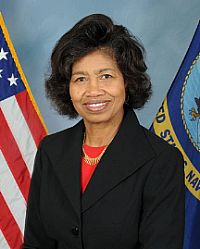
The Department of the Treasury (USDT) is the national treasury and finance department of the federal government of the United States, where it serves as an executive department. The department oversees the Bureau of Engraving and Printing and the U.S. Mint. These two agencies are responsible for printing all paper currency and minting coins, while the treasury executes currency circulation in the domestic fiscal system. The USDT collects all federal taxes through the Internal Revenue Service; manages U.S. government debt instruments; licenses and supervises banks and thrift institutions; and advises the legislative and executive branches on matters of fiscal policy. The department is administered by the secretary of the treasury, who is a member of the Cabinet. The treasurer of the United States has limited statutory duties, but advises the Secretary on various matters such as coinage and currency production. Signatures of both officials appear on all Federal Reserve notes.
Government Accountability Office investigations of the Department of Defense (DoD) are typically audits in which the Government Accountability Office (GAO), the United States Congress' investigative arm, studies how the Department of Defense spends taxpayer dollars. Since the GAO is accountable only to the legislative branch, it is in a unique position to investigate the military; no other agency can audit Federal departments with the same degree of independence from the President. However, the GAO is still subject to influence from powerful members of Congress. As of May 19, 2021, the DoD was the only government agency to have failed every audit since all government agencies were required to pass such audits by the Chief Financial Officers Act of 1990.

The military budget of the United States is the largest portion of the discretionary federal budget allocated to the Department of Defense (DoD), or more broadly, the portion of the budget that goes to any military-related expenditures. The military budget pays the salaries, training, and health care of uniformed and civilian personnel, maintains arms, equipment and facilities, funds operations, and develops and buys new items. The budget funds six branches of the US military: the Army, Navy, Marine Corps, Coast Guard, Air Force, and Space Force.

The comptroller general of the United States is the director of the Government Accountability Office, a legislative-branch agency established by Congress in 1921 to ensure the fiscal and managerial accountability of the federal government.

The Defense Finance and Accounting Service (DFAS) is an agency of the United States Department of Defense (DOD), headquartered in Indianapolis, Indiana. The DFAS was established in 1991 under the authority, direction, and control of the Under Secretary of Defense (Comptroller)/Chief Financial Officer to strengthen and reduce costs of financial management and operations within the DOD. The DFAS is responsible for all payments to servicemembers, employees, vendors, and contractors. It provides business intelligence and finance and accounting information to DOD decisionmakers. The DFAS is also responsible for preparing annual financial statements and the consolidation, standardization, and modernization of finance and accounting requirements, functions, processes, operations, and systems for the DOD.

The state auditor of Minnesota is a constitutional officer in the executive branch of the U.S. state of Minnesota. Nineteen individuals have held the office of state auditor since statehood. The incumbent is Julie Blaha, a DFLer.

The United States Department of Defense is an executive branch department of the federal government of the United States charged with coordinating and supervising all agencies and functions of the U.S. government directly related to national security and the United States Armed Forces. As of June 2022, the U.S. Department of Defense is the largest employer in the world, with over 1.34 million active-duty service members, including soldiers, marines, sailors, airmen, and guardians. The Department of Defense also maintains over 778,000 National Guard and reservists, and over 747,000 civilians bringing the total to over 2.87 million employees. Headquartered at the Pentagon in Arlington County, Virginia, just outside Washington, D.C., the Department of Defense's stated mission is to provide "the military forces needed to deter war and ensure our nation's security".
Executive Schedule is the system of salaries given to the highest-ranked appointed officials in the executive branch of the U.S. government. The president of the United States appoints individuals to these positions, most with the advice and consent of the United States Senate. They include members of the president's Cabinet, several top-ranking officials of each executive department, the directors of some of the more prominent departmental and independent agencies, and several members of the Executive Office of the President.

The Budget and Accounting Act of 1921 was landmark legislation that established the framework for the modern federal budget. The act was approved by President Warren G. Harding to provide a national budget system and an independent audit of government accounts. The official title of this act is "The General Accounting Act of 1921", but is frequently referred to as "the budget act", or "the Budget and Accounting Act".

State auditors are fiscal officers lodged in the executive or legislative branches of U.S. state governments who serve as external auditors, program evaluators, financial controllers, bookkeepers, or inspectors general of public funds. The office of state auditor may be a creature of the state constitution or one created by statutory law.

The Under Secretary of Defense (Comptroller)/Chief Financial Officer, abbreviated USD(C)/CFO, is a high level civilian official in the United States Department of Defense. The Under Secretary of Defense (Comptroller) is the principal staff assistant and adviser to both the Secretary of Defense and the Deputy Secretary of Defense for all budgetary and fiscal matters, including the development and execution of the Defense Department's annual budget.

The United States Army Finance Corps is a combat service support (CSS) branch of the United States Army. The Finance Corps traces its foundation to 16 June 1775, when the Second Continental Congress established the office of Paymaster General of the Army. The Pay Department became a separate department in 1816, and the Finance Department was created by law on 1 July 1920. It became the Finance Corps in 1950. It is responsible for financial operations, most notably payroll and resource management.

The structure of the United States Army is complex, and can be interpreted in several different ways: active/reserve, operational/administrative, and branches/functional areas.

Gladys Lee Commons is the former United States Assistant Secretary of the Navy.

Mary Sally Matiella is an American government official and political candidate who served as the Assistant Secretary of the Army during the Obama Administration. After several decades of federal civil service, Matiella served as the Assistant Secretary of the Army, holding office from February 16, 2010 until February 27, 2014, when she resigned and was succeeded by Robert M. Speer.

Sandra Lee "Sandy" Pack was United States Assistant Secretary of the Army from 2001 to 2003 and Assistant Secretary of the Treasury for Management & Chief Financial Officer from 2005 to 2006.

The Assistant Secretary of the Air Force for Financial Management and Comptroller (SAF/FM) is a civilian official in the United States Department of the Air Force.

The Adjutant General's Corps, formerly the Adjutant General's Department, is a branch of the United States Army first established in 1775. This branch provides personnel service support by manning the force, providing human resources services, coordinating personnel support, Army band operations, and recruiting and retention. The objective of the Adjutant General Corps is to "maximize operational effectiveness of the total force by anticipating, manning, and sustaining military operations. HR support operations accomplish this by building, generating, and sustaining the force providing combatant commanders the required forces for missions and supporting leaders and Soldiers at all levels."

Brigadier General Mark A. McAlister, USA is the former Commanding General of the Soldier Support Institute at Fort Jackson, South Carolina which is responsible for training all of the Army's Human Resource and Financial Management soldiers.

















